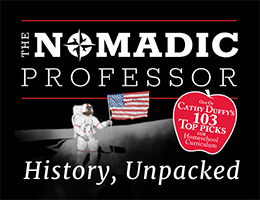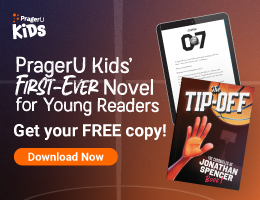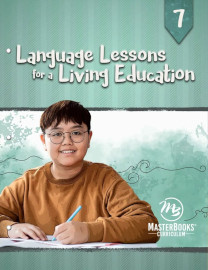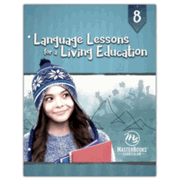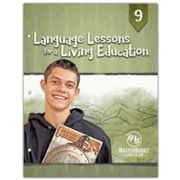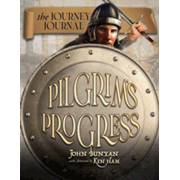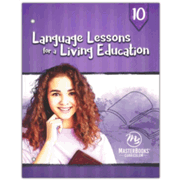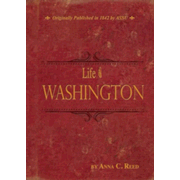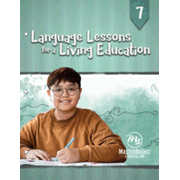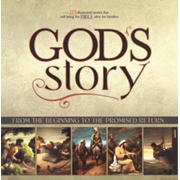Like the Language Lessons for a Living Education courses for younger students, both teacher and student resources are contained in one book for each level for grades seven through ten. Each coursebook is about 500 pages in length, and more than 100 pages at the end provide teacher and student resources, including answer keys.
These courses cover grammar, vocabulary, spelling, composition, and public speaking, as well as literature to some extent. They place a strong emphasis on developing communication skills through both written and oral presentations.
Written for Christian students, these courses promote a Christian worldview. Students will need a Bible or the book God’s Story for levels 7 and 8. They will need Pilgrim's Progress: The Journey Journal for level 9 and Life of Washington for level 10. The supplementary books are all available from Master Books as either paperbacks or PDFs.
Students also need a dictionary, books for independent reading, 3” x 5” index cards, colored pencils, and a notebook.
Each course should take 36 weeks to complete with lessons five days a week. A daily schedule near the front of each book has check-off boxes and space for assigning grades for completed work.
Students should be able to complete most work independently, although they are required to have occasional discussions and make oral presentations. In addition, a teacher or parent should check on mastery of spelling words and Bible verses as they evaluate other student work.
How It Works
The weekly lessons follow the same pattern with exercises labeled for each day.
The first exercise begins with a “Special Feature”—a study of a quotation from a book, a picture, a hymn, a Scripture passage, or a poem. The rest of the exercise is devoted to vocabulary, spelling, and scripture memorization. Vocabulary words are drawn from the special feature, and those same words are used for spelling. A weekly scripture verse and the vocabulary words and their definitions are to be written on 3” x 5” index cards and practiced all week. (I might have students use a notebook rather than notecards, but that’s my personal preference.)
Exercise 2 reviews and expands upon what students should have learned previously regarding grammar and punctuation. They are given plenty of practice applying what they learn in traditional-style exercises. While there is some review, these courses don’t overdo the grammar exercises.
The third exercise helps students develop communication skills: written, oral (e.g., public speaking and interviews), non-verbal, and technological. This is where they learn writing skills including those for essays and research papers. Some grammar instruction is occasionally included in the third exercise with the idea that using proper grammar helps us communicate effectively.
Exercise 4 focuses on scripture and worldview using the supplementary book for each level. Scripture quotations are primarily from the English Standard Version of the Bible, with some also from the KJV, NKJV, and NIV. Students use the Bible, Bible stories, and the other supplementary books for copywork, answering questions, doing literary analysis, learning to take notes and write summaries, sketching (using the colored pencils), and as the basis for discussions with the teacher. Literary analysis includes learning to also do a worldview analysis. For instance, students are presented with a series of questions to consider such as these: “Do you know anything about the beliefs of the author? If so, are the author’s beliefs consistent with what the Bible teaches? How so? Do the facts presented align with a biblical worldview?” (Level 9, p. 217).
The courses’ worldview assumptions are spelled out clearly on page 85 of the level coursebook:
The sixty-six books of the Bible are the written, infallible Word of God. The Bible is divinely inspired and inerrant throughout. Its assertions are factually true in all the original autographs. It is the supreme authority in everything it teaches. Its authority is not limited to spiritual, religious, or redemptive themes but includes its assertions in such fields as history and science.
The fifth day is for review, quizzes, and tests. The reviews draw from all content for the week, including the special feature. Check-off boxes are included for recitation of the weekly Bible verse and mastery of the spelling words.
The lessons often make connections to the special feature throughout the week. For example, the second lesson in level 7 begins with a study of a picture of the Garden of Eden. Students view this picture and imagine what the garden might have been like. They read Genesis 2 and 3 and write their own creative description of the garden. Vocabulary words drawn from the Bible reading are written on cards, studied, used as spelling words, and reviewed in exercises on the second and fifth days that week. Exercises on other days often use content from the special feature in other ways. For instance, on the second day, two exercises regarding run-on sentences and fragments use the story of Adam and Eve as subject matter. The fourth day has students learn about the structure of the Bible, concentrating on the Old Testament.
Tests and Grading
The courses for levels 7 and 8 include a quarterly review as the third lesson every ninth week, and all four levels have weekly reviews which might also serve as tests. The appendices of each book have an Assessments page that explains grading options for the courses. Following the Assessment page are grading rubrics for evaluating compositions and oral presentations.
Some subjective assignments in these courses might be checked off but not graded, such as, “List two aspects of interviewing someone that you enjoy or can learn from” (Level 9, p.228).
Writing
The courses require a substantial amount of writing in the coursebook as well as in a separate notebook (or on a computer). In their notebooks, students will write key points to include in a summary, notes for a character analysis, research notes in the notebook, and other such information they glean as well as some complete writing assignments.
Additional suggestions for writing are found among the “Extra! Extra! Another Chance to Communicate!” ideas and “Optional Bonus Activities” in the appendices. Some of the suggestions involve other types of creativity. While there are far more ideas than students can do, check out the options to identify those most likely to appeal to or be effective for each student.
Independent Reading
The appendices of each book include a recommended book list and a form for tracking independent reading. The books on the recommended reading list are a mixture of fiction and non-fiction, all published by Master Books.
Books to be read are decided between the teacher and the student, and reminders are included in the first exercise each week to update the reading list if needed and discuss what the student has been reading.
You should probably use a separate literature course to ensure that students become familiar with a wide range of literature, and the independent reading requirements of another literature course might suffice. Since these Language Lessons courses include some literary analysis, you do not have to use a separate literature course, but you still need to expand the types of books read beyond the recommended reading list.
Teaching Resources
The section of 100+ pages at the back of each book is titled “Assessments & Grading, Teaching Resources.” This section has its own table of contents since there are so many resources here, including some I have already mentioned, such as the recommended reading list. The types of information included here are similar for each course, but most of the pages are designed specifically for each course. Among them are lists of grammar and spelling rules condensed into reference tools, lists of vocabulary/spelling words for the entire year that can be viewed on just a few pages, word art examples that students might incorporate into their sketches, templates for compositions and presentations, creative ways to practice spelling words, grammar and communication study sheets that summarize key concepts and strategies (e.g., capitalization rules, the use of apostrophes, writing a thesis statement, writing a thesis statement, research and citing sources).
The last item is the answer key which includes key ideas that should be addressed in short-essay type answers. While I love the concept of having everything in a single book, the answer key is the only problem in that it might tempt some students to take shortcuts. The answer key takes up about 50 of the pages in this section, and I would recommend removing it and keeping it separate.
Summary
Language Lessons for a Living Education are one of the few options for language arts for junior and senior high that incorporate the examination of worldviews. Several other features should make these courses appealing to homeschoolers. Students can do much of their work independently since the courses provide supportive guidance for the development of skills. The grammar review seems geared appropriately for students at this level rather than redundant. And the rotation of different special features each week and the variety in the designs of the exercises keep things interesting.
Following are a few more details on each level for those who are interested.
Level 7
Students can use God’s Story or read directly from a Bible, so the purchase of the supplemental book is not required.
For composition lessons, students begin with various types of paragraphs (e.g., descriptive, comparison-contrast). They also start to learn public speaking skills.
Level 8
As with level 7, students can use the Bible in place of God’s Story.
Students expand their writing skills by tackling a descriptive essay, a comparative essay, an expository essay, and a narrative essay. They also learn to create a bibliography.
Level 9
The required book, Pilgrim's Progress: The Journey Journal, has the full text of Pilgrim’s Progress plus worldview notes, character studies, scripture annotations, and wide margins with lines for students’ notes.
For the writing assignments, students will write a personal narrative, plus descriptive, expository, critical, and persuasive essays. Students learn how to create a bibliography and footnotes.
Level 10
Life of Washington by Anna C. Reed was originally published in 1842 and was widely read at the time. Reed focused on the faith of Washington in this laudatory biography. For instance, on page 19 she writes: “His history is as a shining light upon the path of virtue; for he ‘acknowledged God in all his ways.’” Life of Washington is used in the first semester, and two optional autobiographies are the sources of material for the second semester: The Summit by Eric Alexander and Gifted Mind by Jeff Kinley and Dr. Raymond Damadian. Excerpts from these two books are included in the course book, so you do not need to purchase them.
The worldview activities at this level expand more broadly into all areas of life as students explore the lives of Washington, Alexander (a mountain climber), and Damadian (inventor of the MRI scanner).
Students will write several essays plus a biography of a famous person and their own autobiography. They will do oral presentations on the biography and autobiography. They also learn the MLA style of citation for researched papers.





